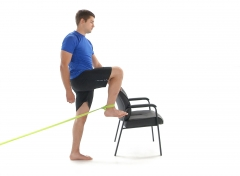5 Exercises to Prepare for a Successful Running Season
- K-Town Physio

- May 6, 2021
- 4 min read
Updated: May 18, 2021

Spring is here and what better way to enjoy the outdoors than to go for a run! For some, the Spring allows for the transition from treadmill to outdoor running and for others, it is the chance to begin the love/hate relationship that many of us have with this sport. No matter your level of experience, and even if you have been running outdoors all winter, incorporating these five strengthening exercises into your routine can help set up the foundation for an efficient run and decrease the likelihood for running-related pain and injury.
Monster Walks – Target Muscles: gluteus medius, gluteus minimus
The lesser-known gluteal muscles, medius and minimus, have the oh-so important role of stabilizing your hip while standing on one leg. Which is A LOT when you’re running. Not only that, but they also help to keep your pelvis level while standing on one leg. Failure to do either of these things can lead to the development of hip and/or knee pain.
Place a mini-band around the thighs, just above the knee or around the lower leg near the ankle.
In a partial squat position, take a step sideways using your abductors (gluteus medius), without rotating at the hips.
Tips
Keep the band taut for the duration of the movement.
Keep the back straight and knees in line with your toes.
Keep the toes pointing forward at all times.
Step Ups – Target Muscle: gluteus maximus.
The powerhouse of the gluteals, maximus’ job is to extend your hip. It provides the push-off strength that propels you forward during your run. If your glute max is weak (or not contributing at all to your running) you may find yourself with an inefficient stride. Another common sign that your glutes might not be coming to the party is pain in the front of your hips or along your groin line, which may indicate that these muscles are doing most of the work.
Stand with the involved leg up on a step and shift your weight over your knee.
Step up slowly, pushing down through the heel, keeping your knee cap in line with your 2nd toe and your pelvis level.
Step back down leading with the uninvolved leg.
Calf Raises (2 ways) – Target Muscles: gastrocnemius, soleus.
The calf, as it is most commonly known, is made up of two muscles. These muscles are integral to the push-off phase of your stride during walking and running. Much like the gluteus maximus, strong muscles in your calf will help to propel you forward with more power and efficiency. Weak or under-utilized calf muscles can also lead to pain along the hip flexors and groin line as a sign of overcompensation.
Stand on a step, placing only your forefeet on it.
Lift yourself up onto your toes as high as you can.
Lower your heels until you feel a stretch in your calves.
Tip
Perform with knees slightly bent.
Standing Marches – Target Muscles: rectus femoris, iliacus, psoas (iliopsoas).
With all of this talk about the pushing phase of the running stride it is only fair (and necessary) that we balance it out with some pulling. As you transition from the push-off phase of the gait cycle, you move into the swing phase, and that is where the hip flexors come in. Many folks have “tight” hip flexors and think that because they are short in length they do not need to be strengthened. Not so, my friend! Like any other muscle that will be contracting repeatedly over a length of time (i.e., running), the muscle needs to be strong in order to sustain the effort. Strong hip flexors equal a strong stride.
Tie an elastic behind you at ankle level.
Tie the other end to your ankle and stand with your leg straight.
Pull your knee upwards fast and let it go back down slowly.
Tip
Keep the trunk stable during the execution.
Plank/Side Plank – Target Muscles: transverse abdominus, internal/external obliques, rectus abdominus.
Many of the muscles that have been highlighted in this article have attachments on the pelvis. The stability of the pelvis is an important factor to consider when training for any sport or activity – whether it is running, weightlifting, yoga, etc. In order to move efficiently, we need a stable foundation from which to move from. Core strengthening does just that.
Plank
Start in all fours then lower yourself on your forearms to form a straight line – with your elbows under your shoulders.
Contract your core and glutes without arching your lower back. Keep your body in a straight line—from your head to your knees.

Side Plank
Lie on your side with knees bent to 90 degrees and the legs in line with the body.
With your upper body supported on your elbow, make sure the elbow is directly under the shoulder.
Engage your core by recruiting your pelvic floor and transverse abdominis.
Press down through your knee and forearm and lift your hips until your body is aligned.
There you have it – five exercises to address some of the common weaknesses found in runners of all levels (myself included!). Work towards completing 3 sets of 10 repetitions/30 second holds. This list is far from exhaustive, and does not include any flexibility or mobility work, so if you find that you are still struggling with running related pain, come in and see one of our therapists, there might be something else that needs to be addressed!
Written by Stephanie Barnes, Registered Physiotherapist
Video/Exercises courtesy of Physiotec





















